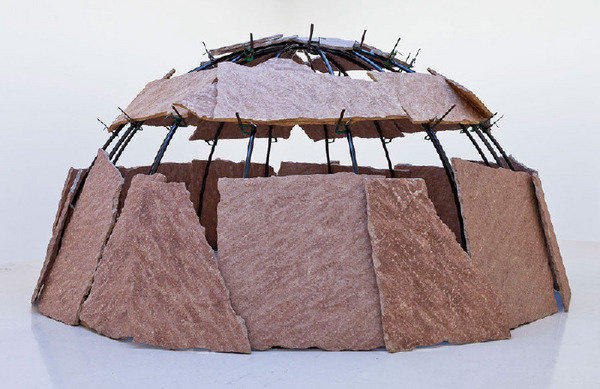Mario Merz
dal 8/6/2013 al 24/6/2013
Segnalato da
8/6/2013
Mario Merz
Gagosian Gallery, Paris
The igloos embody Merz's ruminations on the limitless, which include 'continuous drawings' -in which pencil was never lifted from paper- and paintings that seem to continue beyond their supports. Open forms modelled on spiral foundations refer to the Fibonacci series, a mathematical sequence that was of sustained and pervasive fascination to him.

The home is a relationship between space and time. Time is the creator and destructor of space. Space is not autonomous and static. Space is controlled by time.
—Mario Merz
Gagosian Paris is pleased to present a selection of works by Mario Merz. Merz's work was first shown at Gagosian London in 2006.
Merz was a key member of Arte Povera, the post-war Italian movement predicated on elemental and quotidian materials which Germano Celant introduced with the historic exhibition “Arte Povera: IM Spazio” in 1967. He often combined canvases and found objects with standard neon tubes to mark the moment when materials meet: the ecstatic act of artistic production. Beams of white light seem to pass through Impermeabile / Raincoat (1967), the wall-mounted sculpture that is an early example of Merz’s innovative combining of neon with common objects; or painted canvases, as in I giganti boscaiuoli / The Giant Woodsmen (1981–82), the first in a series of large-scale, mixed-media paintings from the early 1980s. On the unstretched canvas, two cones spiral into the peak of a mountainous black triangle, while the legs of two figures, truncated by the top of the painting, walk across this central point of contact. In the dream-like montage, personal themes and symbols meet Futurist evocations of power and speed. Echoing the propulsive force of the cones, a neon tube forming a bright white vector passes through both the canvas and the third dimension.
In addition to the everyday materials that shaped his ethos, Merz's leitmotif was the igloo, representing the ideal organic shape—"both a world and a small house.” Consistent with the culture and technology of nomadic structures built with resources at hand, Merz made his igloos from earth, cloth, putty, fruit, wax, wood, glass, and animal parts. Despite the visual touchstones—the domed roof and organic components—any resemblance to functional huts or insulated ice houses ends here. Igloo (2002) is comprised of large, overlapping stone fragments, held together by industrial clamps. Through the gaps between shards, the metal framework is visible from all angles: it is a space that is discrete yet visually accessible in its adaptation of vernacular architecture. Igloo inverts the traditional structure on which it is based both literally and conceptually, transforming a resilient shelter into a precarious sculpture.
The igloos embody Merz’s ruminations on the limitless, which include “continuous drawings”—in which pencil was never lifted from paper—and paintings that seem to continue beyond their supports. Open forms modelled on spiral foundations refer to the Fibonacci series, a mathematical sequence that was of sustained and pervasive fascination to him. Private spaces for public contemplation, sculptural structures freed from sculptural conventions and supports, the igloos represent Merz's most audacious and enduring dissolution of limitations.
Mario Merz was born in Milan in 1925, where he died in 2003. His work has been collected by museums worldwide, including the Museum of Modern Art, New York; Solomon R. Guggenheim Museum, New York; Hirshhorn Museum and Sculpture Garden, Washington, D.C.; Museum of Contemporary Art, Los Angeles; Museum of Fine Arts, Boston; Walker Art Center, Minneapolis; San Francisco Museum of Modern Art; Tate Modern, London; Centre Pompidou, Paris; and Museo Nacional Centro de Arte Reina Sofía, Madrid. Major exhibitions include “Mario Merz,” Walker Art Center, Minneapolis (1972); Kunsthalle Basel (1975); Musée d'art Moderne de la Ville de Paris (1975); Whitechapel Art Gallery, London (1980); “Mario Merz at MOCA,” Museum of Contemporary Art, Los Angeles (1989); “Mario Merz: A Retrospective," Guggenheim Museum, New York (1989), a two-venue retrospective at Castello di Rivoli and Galleria d’Arte Moderna, Turin (2005), organized by Fondazione Merz, and “Mario Merz: Che Cos’è una Casa?,” Fondazione Merz, Turin (2010–11). He received the Praemium Imperiale from the Japan Art Association in 2003.
Image: Igloo, 2002. Metal tubular, clips, and irregular stone fragments 70 7/8 x 196 7/8 x 196 7/8 inches (180 x 500 x 500 cm) © 2013/Artists Rights Society (ARS), New York / SIAE, Rome
Photo by Zarko Vijatovic
Press Enquiries Claudine Colin Communication
Contact: Eloïse Daniels T. +33.1.42.72.60.01 E. eloise@claudinecolin.com
Opening reception: Sunday, June 9th, from 11:00am to 2:00pm
Gagosian Paris
4 rue de Ponthieu 75008 Paris
Hours: Tue-Sat 11-7 & by appointment
Admission free



